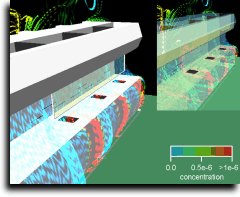 Air flow showing contamination path over a typical wetbench modeled using Flovent from Flomerics |
May 2000 |
|
The technologies used for manufacturing semiconductor devices depend heavily on chemical processes which demand adequate ventilation not only to protect the process environment but also to safeguard employees working in the production facility. If a ventilation problem arises, it is essential to resolve it as quickly as possible to minimize costly downtime for troubleshooting and repair. Consider the case of one manufacturer - SGS-Thomson of Milan, Italy - that was experiencing an unusual problem involving a wet bench application that uses pools of caustic chemicals to process semiconductor wafers. Staff members observed unexplained depositions of these chemicals in the form of a fine yellow dust in the vicinity of three wet benches. This dust appeared on the lower portions of the bench exteriors, on the benches' interior return sections where air was drawn out, and on the surrounding floor where employees might walk on it and track it through the facility. The immediate consequences were a risk of wafer contamination, excessive down time for cleaning and maintenance, and a potential hazard for employees working in the area. t was apparent that emitted chemical vapors were being transported in the air circulating through and around the wet benches.Unclear was the mechanism that caused the chemical deposition problem, and how to eliminate it. To quickly gain a better understanding of the problem and determine the best way to resolve it, SGS-Thomson contacted the Flovent Modeling Services Group, part of Flomerics' Flovent division, which specializes in software for air flow simulation and analysis. Flovent software uses mathematical modeling methods based on Computational Fluid Dynamics (CFD) techniques to accurately calculate environmental factors, such as air flow, heat transfer, and contamination distribution in three dimensional spaces. Prior to building and analyzing the model, Flovent engineers went on site to evaluate the geometry and air flow characteristics of the wet bench and its surrounding environment. The three benches were situated in a room measuring 11m long x 4.6m wide x 2.65m high with a 1.1m ceiling plenum. Also occupying the room were three centrifugal dryers and some other miscellaneous equipment. Seven filter fan units supplied 8,000 m3/hr each; 85% of the air was re-circulated, 14% of the air was fresh. At the same time they obtained pertinent information about the chemicals of interest, including measurements of concentrations at various locations in and around the benches as well as throughout the room. Armed with this data, the engineers proceeded to build the Flovent simulation, which they subsequently analyzed to determine what was causing the undesired chemical deposition. Analysis of the simulation revealed a direct correlation between the deposition problem and the manner in which a protective vertical glass sash was mounted on the bench at the workers' face level. Below the sash was a slot through which workers inserted their gloved hands to use the wet bench. The Flovent simulation showed that if the sash were shortened to increase the open area of the slot, the velocity of the air circulating through the wet bench would correspondingly be reduced. This, in turn, would reduce the amount of chemical contamination being transported with the flow, thereby alleviating the chemical deposition problem. In addition, data from the simulation also suggested the best way to optimize the extraction rates through the slots behind the chemical baths. With the Flovent results in hand, SGS-Thomson quickly and inexpensively solved the problems by shortening the sash on the wet bench from 400mm to 220mm to enlarge the access slot, and by optimizing the extraction rate. Subsequent investigation revealed that the yellow chemical deposition had been eliminated. |










 沪公网安备 31010602003953号
沪公网安备 31010602003953号